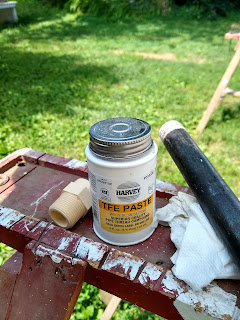The Oakdale Hydroponic Strawberry Patch
The Farm Report 09-20-2019
 |
| Working outside is such a pleasure. For this project, precision isn't all that important, so I'm comfortable working on sawhorses outdoors. |
 |
| There are two pipe threaded fittings in each pipe - one on each end. |
 |
| After drilling and threading the holes, I screwed in a simple little CPVC pipe to tubing adapter. |
 |
| 'Taint fancy, but it works. It's all you really need to thread plastic pipe. |
 |
| See how it works. Getting the 'tap' started in straight is important. Yes! You can thread a hole crooked. |
 |
| They say a pessimist is actually an optimist with experience. So I added some teflon pipe goo onto the threads when I screwed in the fittings. Belt and suspenders you know.... |
 |
| I screwed the fitting in as tight as it would go without stripping the threads. That means on-half turn from disaster, kids. |
 |
| The fitting threads stick out far enough that I can screw on a hose adapter fitting when I hook it all up. That lesson will be in another tutorial posting. More to come. |
 |
| These are the stanchions that will hold the pipes. I got one painted before I remembered to get out my camera. They're both equally strong, but if I don't paint 'em now, they'll never get painted. |
 |
| Out in the orchard, we're finishing up with the Stanley plums. They are so good. These are the last for me for this year. |












